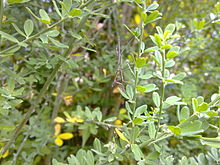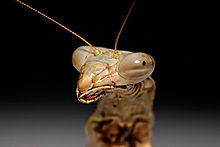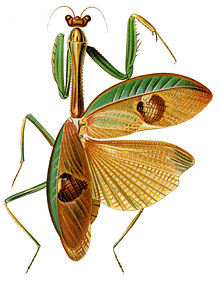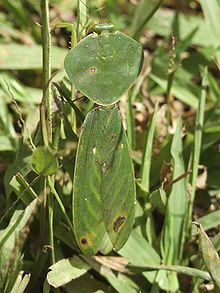- Mantis
-
For other uses, see Praying mantis (disambiguation) and Mantis (disambiguation).
Mantodea
Temporal range: 145–0 Ma Cretaceous–Recent
Sphodromantis viridis Scientific classification Kingdom: Animalia Phylum: Arthropoda Class: Insecta Subclass: Pterygota Infraclass: Neoptera Superorder: Dictyoptera Order: Mantodea
Burmeister, 1838Families Acanthopidae
Amorphoscelidae
Chaeteessidae
Empusidae
Eremiaphilidae
Hymenopodidae
Iridopterygidae
Liturgusidae
Mantidae
Mantoididae
Metallyticidae
Sibyllidae
Tarachodidae
Thespidae
ToxoderidaeSynonyms - Manteodea Burmeister, 1829
- Mantearia
- Mantoptera
Mantodea (or mantises) is an order of insects that contains approximately 2,200 species in 15 families[1] worldwide in temperate and tropical habitats. Most of the species are in the family Mantidae. Historically, the term mantid was used to refer to any member of the order because for most of the past century, only one family was recognized within the order; technically, however, the term only refers to this one family, meaning the species in the other 14 recently established families are not mantids, by definition (i.e., they are empusids, or hymenopodids, etc.), and the term "mantises" should be used when referring to the entire order.
A colloquial name for the order is "praying mantises", because of the typical "prayer-like" stance, although the term is often misspelled as "preying mantis" since mantises are predatory.[2] In Europe, the name "praying mantis" refers to Mantis religiosa. The closest relatives of mantises are the orders Isoptera (termites) and Blattodea (cockroaches), and these three groups together are sometimes ranked as an order rather than a superorder. They are sometimes confused with phasmids (stick/leaf insects) and other elongated insects such as grasshoppers and crickets.
Contents
Etymology
The scientific name Mantodea comes from the Greek words μάντις meaning a prophet, and εἶδος for form or shape. The name was coined in 1838 by the German entomologist Hermann Burmeister. The common term mantis is also from the Greek word μάντις for prophet.[3][4]
Systematics
See also: List of mantis genera and speciesThe systematics of mantises have long been disputed. Mantises, along with walking sticks, were once placed in the order Orthoptera with the cockroaches (now Blattodea) and rock crawlers (now Grylloblattodea). Kristensen (1991) combined Mantodea with the cockroaches and termites into the order Dictyoptera.[5]
Anatomy and morphology
.
Mantises have two grasping, spiked forelegs ("raptorial legs") in which prey items are caught and held securely. Located at the base of the femur are a set of discoidal spines, usually four in number but ranging from zero to as many as five depending on the species. These spines are preceded by a number of tooth-like tubercles, which, along with a similar series of tubercles along the tibia and the apical claw near its tip, give the foreleg of the mantis its grasp on its prey. The foreleg ends in a delicate tarsus made of between four and five segments and ending in a two-toed claw with no arolium and used as a walking appendage.[6]
The mantis thorax consist of a prothorax, a mesothorax, and a metathorax. In virtually all species the prothorax, to which are attached the head and forelegs, is much longer than the other two thoraces (the sole exceptions are the seven members of the Mantoididae family). The prothorax is also flexibly articulated, allowing for a wide range of movement of the front limbs while the remainder of the body remains more or less immobile.
The articulation of the head is also remarkably flexible, permitting nearly 300 degrees of movement in some species, allowing for a great range of vision (their compound eyes may contain up to 10,000 ommatidia and have a large binocular field of vision). As their hunting relies heavily on vision, they are primarily diurnal, but many species will fly at night, especially males in search of less-mobile females whom they can detect through pheromones. Flying at night allows these males to avoid many diurnal bird predators, and many mantises also have an auditory thoracic organ that assists them as they attempt to avoid capture by bats by detecting the presence of the bat's echolocation sounds and responding evasively.[7]
Mantises have a wide range of wing morphologies and can be loosely categorized as being either macropterous (long-winged), brachypterous (short-winged), micropterous (vestigial-winged), or as apterous (wingless). If not wingless, a mantis will have two sets of wings: the outer wings, called the foreseeing or tegmina, are usually narrow, opaque, and leathery and function as camouflage and as a shield for the inner wings, or hindwings-- it is this much more delicate, broad, and transparent set that is actually used for flight, though in many of the brachypterous species these wings are only capable of producing minimal and very temporary lift and in the micropterous species they have no flight-related function at all. Also, in many macropterous species, the female will have much shorter wings than the male and will only rarely take flight.
The abdomen of all mantises consist of ten tergites with a corresponding set of nine sternites visible in males and seven visible in females. The slim abdomen of most males allows them to take flight more easily while the thicker abdomen of the females houses the reproductive machinery for generating the ootheca. The abdomen of both sexes ends in a pair of cerci.
Evolution
One theory for the evolution of the species is that mantises evolved from proto-cockroaches, diverging from their common ancestors by the Cretaceous period, possibly from species like Raphidiomimula burmitica, a predatory cockroach with mantis-like forelegs. Possibly the earliest known modern mantis is Regiata scutra, although more common (and confirmed) is Santanmantis, a stilt-legged genus, also from the Cretaceous. Like their close termite cousins, though, mantises did not become common and diverse until the early Tertiary period.
Behavior
Diet and predatory behaviour
 Tenodera sinensis preying on a cricket
Tenodera sinensis preying on a cricket
Mantises are exclusively predatory. Insects form the primary diet, but larger species have been known to prey on small scorpions, lizards, frogs, birds, snakes, fish, and even rodents; they will prey upon any species small enough to successfully capture and devour. Most species of mantis are known to engage in cannibalism. The majority of mantises are ambush predators, waiting for prey to stray too near. The mantis then lashes out at remarkable speed. Some ground and bark species, however, pursue their prey. Prey items are caught and held securely with grasping, spiked forelegs.
Defense and camouflage
Generally, mantises protect themselves by camouflage and concealment. When directly threatened, many mantis species stand tall and spread their forelegs, with their wings fanning out wide. The fanning of the wings makes the mantis seem larger and more threatening, with some species having bright colors and patterns on their hind wings and inner surfaces of their front legs for this purpose. If harassment persists, a mantis may strike with its forelegs and attempt to pinch or bite. As part of the threat display, some species also may produce a hissing sound by expelling air from the abdominal spiracles. When flying at night, at least some mantises are able to detect the echolocation sounds produced by bats, and when the frequency begins to increase rapidly, indicating an approaching bat, they will stop flying horizontally and begin a descending spiral toward the safety of the ground, often preceded by an aerial loop or spin.[8][9]
Mantises, like stick insects, show rocking behaviour in which the insect makes rhythmic, repetitive side-to-side movements. Functions proposed for this behaviour include the enhancement of crypsis by means of the resemblance to vegetation moving in the wind. However, the repetitive swaying movements may be most important in allowing the insects to discriminate objects from the background by their relative movement, a visual mechanism typical of animals with simpler sight systems. Rocking movements by these generally sedentary insects may replace flying or running as a source of relative motion of objects in the visual field.[10]
Mantises are camouflaged, and most species make use of protective coloration to blend in with the foliage or substrate, both to avoid predators themselves, and to better snare their prey. Various species have evolved to not only blend with the foliage, but to mimic it, appearing as either living or withered leaves, sticks, tree bark, blades of grass, flowers, or even stones. Some species in Africa and Australia are able to turn black after a molt following a fire in the region to blend in with the fire ravaged landscape (a type of adaptive melanism referred to as fire melanism). While mantises can bite, they have no venom. They can also slash captors with their raptorial legs (which is often preceded by a threat display wherein the mantis will rear back and spread its front legs and wings (if present), often revealing vivid colors and/or eyespots to startle a predator). Mantises are without chemical protection; many large insectivores will eat a mantis, including Scops owls, shrikes, bullfrogs, chameleons, and milk snakes.
Reproduction and life history
 A recently laid mantis ootheca
A recently laid mantis ootheca
Sexual cannibalism is common among mantises in captivity, and under some circumstances may also be observed in the field. The female may start feeding by biting off the male’s head (as they do with regular prey), and if mating had begun, the male’s movements may become even more vigorous in its delivery of sperm. Early researchers thought that because copulatory movement is controlled by a ganglion in the abdomen, not the head, removal of the male’s head was a reproductive strategy by females to enhance fertilisation while obtaining sustenance. Later, this behavior appeared to be an artifact of intrusive laboratory observation. Whether the behavior in the field is natural, or also the result of distractions caused by the human observer, remains controversial. Mantises are highly visual organisms, and notice any disturbance occurring in the laboratory or field such as bright lights or moving scientists. Research by Liske and Davis (1984)[11] and others found (e.g. using video recorders in vacant rooms) that Chinese mantises that had been fed ad libitum (so that they were not hungry) actually displayed elaborate courtship behavior when left undisturbed. The male engages the female in courtship dance, to change her interest from feeding to mating. Courtship display has also been observed in other species, but it does not hold for all mantises.
The reason for sexual cannibalism has been debated, with some considering submissive males to be achieving a selective advantage in their ability to produce offspring. This theory is supported by a quantifiable increase in the duration of copulation among males who are cannibalized, in some cases doubling both the duration and the chance of fertilization. This is further supported in a study where males were seen to approach hungry females with more caution, and were shown to remain mounted on hungry females for a longer time, indicating that males actively avoiding cannibalism may mate with multiple females. The act of dismounting is one of the most dangerous times for males during copulation, for it is at this time that females most frequently cannibalize their mates. This increase in mounting duration was thought to indicate that males would be more prone to wait for an opportune time to dismount from a hungry female rather than from a satiated female that would be less likely to cannibalize her mate. Some consider this to be an indication that male submissiveness does not inherently increase male reproductive success, rather that more fit males are likely to approach a female with caution and escape.[12][13]
The mating season in temperate climates typically begins in autumn. To mate following courtship, the male usually leaps onto the female’s back, and clasps her thorax and wing bases with his forelegs. He then arches his abdomen to deposit and store sperm in a special chamber near the tip of the female’s abdomen. The female then lays between 10 and 400 eggs, depending on the species. Eggs are typically deposited in a frothy mass that is produced by glands in the abdomen. This froth then hardens, creating a protective capsule with a further protective coat, and the egg mass is called an ootheca. Depending on the species these can be attached to a flat surface, wrapped around a plant or even deposited in the ground. Despite the versatility and durability of the eggs, they are often preyed on, especially by several species of parasitic wasps. In a few species, the mother guards the eggs.
As in related insect groups, mantises go through three stages of metamorphosis: egg, nymph, and adult (mantises are among the hemimetabolic insects). The nymph and adult insect are structurally quite similar, except that the nymph is smaller and has no wings or functional genitalia. The nymphs are also sometimes colored differently from the adult, and the early stages are often mimics of ants. A mantis nymph increases in size (often changing its diet as it does so) by replacing its outer body covering with a sturdy, flexible exoskeleton and molting when needed. This can happen from five to ten times, depending on the species. After the final molt most species have wings, though some species are wingless or brachypterous ("short-winged"), particularly in the female sex.
In tropical species, the natural lifespan of a mantis in the wild is about 10–12 months, but some species kept in captivity have been sustained for 14 months. In colder areas, females will die during the winter (as well as any surviving males).
Pest control uses
Organic gardeners who avoid pesticides may encourage mantises as a form of biological pest control. Tens of thousands of mantis egg cases are sold each year in some garden stores for this purpose.
During fall, praying mantis females deposit an ootheca on the underside of a leaf or on a twig. If the egg case survives winter, the offspring, called nymphs, emerge in late spring or early summer. The nymphs have voracious appetites and typically cannibalize each other if they cannot find an adequate supply of aphids and other small insects. Egg cases are commercially available for placement in landscaping.[14]
However, mantises prey on neutral and beneficial insects as well, basically eating anything they can successfully capture and devour.
Conservation status
 An adult Chinese Mantis perched in a tree in camouflage in Maryland.
An adult Chinese Mantis perched in a tree in camouflage in Maryland.
 An immature Pseudomantis albofimbriata in south east Australia.
An immature Pseudomantis albofimbriata in south east Australia.
Only one Spanish species, Apteromantis aptera, is listed as Lower Risk/Near Threatened. With one exception (the ground mantis Litaneutria minor in Canada, where it is rare — though it is common in the United States), North American mantises are not included among threatened or endangered species, though species in other parts of the world are under threat from habitat destruction. The European mantis (Mantis religiosa) is the state insect of Connecticut, but the General Statutes of Connecticut do not list any special protected status, as it is a non-native species from Europe and Africa.[15]
There is a long-standing American urban legend that killing a praying mantis is illegal and subject to a fine. The origin of this myth is unknown but may have originated due to the low number of sightings of mantis and because of how beneficial they are to gardens in which they live.[16]
Introduced species
About 20 species are native to the United States, including the common Carolina mantis, with only one native to Canada. Two species (the Chinese mantis and the European mantis) were deliberately introduced to serve as pest control for agriculture, and have spread widely in both countries. Additionally, there is a strong market in the exotic pet trade for mantis species from Asia and Africa, and many species are bred in captivity for this purpose.
Cultural references
One of the earliest mantis references is in the ancient Chinese dictionary Erya, which gives its attributes in poetry (representing courage and fearlessness), as well as a brief description. A later text, the Jingshi Zhenglei Daguan Bencao 經史證類大觀本草 ("Bencao of the Daguan period, Annotated and Arranged by Types, Based upon the Classics and Historical Works") from 1108, is impressively correct on the construction of the egg packages, the development cycle, the anatomy and even the function of the antennae.
Western descriptions of the biology and morphology of the mantises had become relatively accurate by the 18th century. Roesel von Rosenhof accurately illustrated and described them in the Insekten-Belustigungen (Insect Entertainments). Aldous Huxley made philosophical observations about the nature of death while two mantises mated in the sight of two characters in the novel Island (the species was Gongylus gongylodes). The naturalist Gerald Durrell's autobiography My Family and Other Animals includes an account of a very evenly matched battle between a mantis and a gecko. Based upon empirical evidence, the Australian mantis has been known to strike fear amongst the native Australian gecko causing great avoidance tendencies as it marks its territory.
M. C. Escher's woodcut Dream depicts a human-sized mantis standing on a sleeping monk.[17]
Kamacuras from the Toho produced Godzilla series is a gigantic praying mantis that appear in Son of Godzilla (1967), Godzilla's Revenge (1969), and Godzilla: Final Wars (2004). In Son of Godzilla, a species of man-sized praying mantises lived on Sollgel Island. Later, a radioactive accident that occurred due to a weather experiment mutated the insects into even larger proportions. They, now the size of buildings, became known as Kamacuras. In Godzilla: Final Wars, Kamacuras made an appearance as one of the many controlled monsters of a race of superior extraterrestrial beings known as the Xiliens. It attacks Paris, France and is teleported away by an enormous UFO to make it seem as if the Xiliens eliminated every kaiju. Kamacuras is defeated when Godzilla impales him on an electrical tower later on in the movie.
In 1957, a science-fiction B Movie was released under the title, The Deadly Mantis. In the movie, a volcano explodes, eventually causing North Pole icebergs to shift. Below the melting polar ice caps, a 200-foot-long pre-historic praying mantis, trapped in the ice, is stirred to life again. It flies in a southerly route, causing havoc on cities in the United States and Canada. The movie is best known for being mocked by Mystery Science Theater 3000.
In the Buffy the Vampire Slayer episode, Teacher's Pet (Buffy the Vampire Slayer), Xander is seduced by an enchanting biology teacher who turns out to be a giant, sentient praying mantis.
In the Pokémon universe, Scyther, and its evolution Scizor are Pokémon based upon a mantis.
In Portal 2, Cave Johnson is heard in a pre-recorded message that strongly implies that he inadvertently created a rebelling army of "mantis-men" by injecting humans with mantis DNA.
Also in the movies Kung Fu Panda and its sequel, a mantis is one of the Kung Fu styles personified in the Furious Five.
In the Metal Gear Solid series, one of the most popular antagonists is called Psycho Mantis.
In the CBS television series The Big Bang Theory, characters Leonard and Penny describe Sheldon as resembling a praying mantis.
Mythology
Southern African indigenous mythology refers to the praying mantis as a god in Khoi and San traditional myths and practices, and the word for the mantis in Afrikaans is hottentotsgot (literally, the god of the Khoi).[18][19]
Sources
- Ehrmann, Reinhard (2002) (in German). Mantodea Gottesanbeterinnen der Welt. Münster: Natur und Tier-Verlag. ISBN 978-3931587604.
- Klausnitzer, Bernhard (1987). Insects: Their Biology and Cultural History. Unknown. ISBN 0-87663-666-0.
- O'Toole, Christopher (2002). Firefly Encyclopedia of Insects and Spiders. Firefly. ISBN 1-55297-612-2.
- Checklist of Mantodea originally compiled by the Los Angeles County Museum
- Tree of Life — Mantodea
References
- ^ ITIS Catalogue of Life
- ^ "National Geographic:Praying Mantis". http://animals.nationalgeographic.com/animals/bugs/praying-mantis/. Retrieved January 2011.
- ^ Essig, Edward Oliver (1947). College entomology. New York: Macmillan Co.. p. 900. OCLC 809878. http://books.google.ca/books?cd=3&id=IXpXAAAAMAAJ&dq=Mantodea+Burmeister%2C+1838&q=prophet#search_anchor. Retrieved 2010-03-10.
- ^ Harper, Douglas. "mantis". Online Etymology Dictionary. http://www.etymonline.com/index.php?term=mantis. Retrieved 21 November 2008.
- ^ Costa, James. The other insect societies. Harvard University Press. pp. 135–136. ISBN 0674021630. http://books.google.com/books?id=PYRFDrZs9QAC&pg=PA135&dq=Mantodea&lr=&ei=zbMyS6_BLpqIlQSZuLy5AQ&client=safari&cd=3#v=onepage&q=Mantodea&f=false.
- ^ Prete, Fredrick R. (1999). The praying mantids. Baltimore, MD: Johns Hopkins University. pp. 27-29. ISBN 0801861748.
- ^ Prete, Fredrick R. (1999). The praying mantids. Baltimore, MD: Johns Hopkins University. pp. 101-103. ISBN 0801861748.
- ^ Yager, D., May, M. (1993) Coming in on a Wing and an Ear. (Cover Story). Natural History 102.1: 28.
- ^ [1] Praying Mantis Uses Ultrasonic Hearing to Dodge Bats
- ^ O'Dea, JD. Eine zusatzliche oder alternative Funktion der 'kryptischen' Schaukelbewegung bei Gottesanbeterinnen und Stabschrecken (Mantodea, Phasmatodea). Entomologische Zeitschrift, 101, Nr. 1/2, 15 January 1991, 25–27.
- ^ http://www.snopes.com/critters/wild/mantis1.asp
- ^ J. P. Lelito and W. D. Brown (2006) Sexual conflict in a praying mantis. The American Naturalist 168[2].
- ^ Jonathan P. Lelito and William D. Brown (2006), Complicity or Conflict over Sexual Cannibalism? Male Risk Taking in the Praying Mantis Tenodera aridifolia sinensis. The American Naturalist 168:263-269.
- ^ Praying mantis Preys on Insect Pests
- ^ State of Connecticut, The State Insect, August 5, 2002; accessed 2011.01.05.
- ^ Pray or Pay Long-standing American urban legend that killing a praying mantis is illegal. Snopes.com, June 29, 2007.
- ^ "Escher, M. C., 1898-1972, Dream (Mantis religiosa). Woodengraving, April, 1935, signed". Treasures of Lauinger Library. Georgetown University. http://gulib.georgetown.edu/dept/speccoll/treasures/Images/jpg/escher.jpg. Retrieved May 14, 2011.
- ^ "South Africa - Religion". Countrystudies.us. http://countrystudies.us/south-africa/52.htm. Retrieved 2010-07-14.
- ^ "Forums • View topic - Afrikaans Animal Names". Sanparks.org. http://www.sanparks.org/forums/viewtopic.php?f=31&t=23300&start=30. Retrieved 2010-07-14.
External links
- Mantis Study Group Information on mantids, scientific article phylogenetics and Evolution.
- Mantodea Revisionary Systematics and Phylogenetics.
Orders of Insects (Wikispecies) Extant Archaeognatha • Blattodea (Cockroaches) • Coleoptera (Beetles) • Dermaptera (Earwigs) • Diptera (Flies) • Embioptera (Webspinners) • Ephemeroptera (Mayflies) • Hemiptera • Hymenoptera • Isoptera (Termites) • Lepidoptera • Mantodea (Mantises) • Mecoptera • Megaloptera • Neuroptera • Notoptera • Odonata • Orthoptera • Phasmatodea • Phthiraptera (Lice) • Plecoptera • Psocoptera • Raphidioptera (Snakeflies) • Siphonaptera (Fleas) • Strepsiptera • Thysanoptera (Thrips) • Trichoptera (Caddisflies) • Zoraptera • Zygentoma (Thysanura)
Extinct Categories:- Mantodea
- Orders of insects
- Agriculturally beneficial insects
- Biological pest control agents
- Pet insects
Wikimedia Foundation. 2010.






